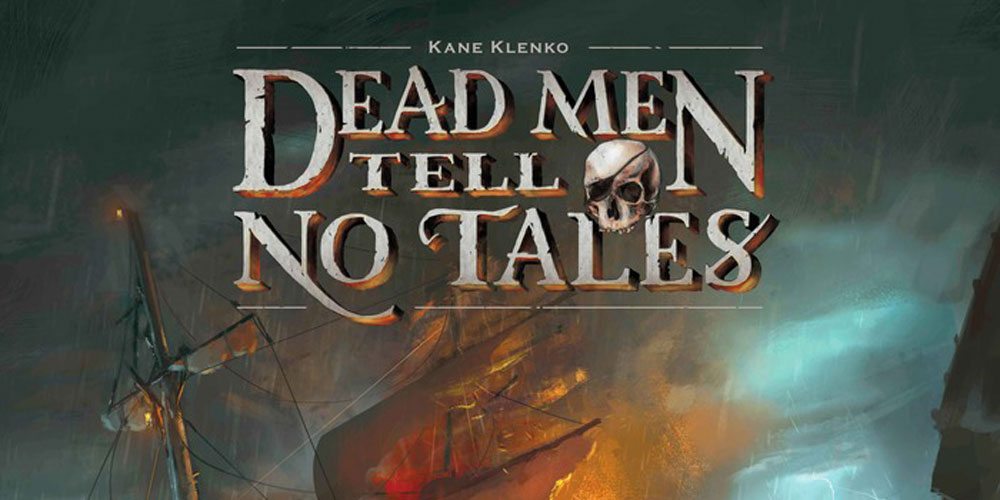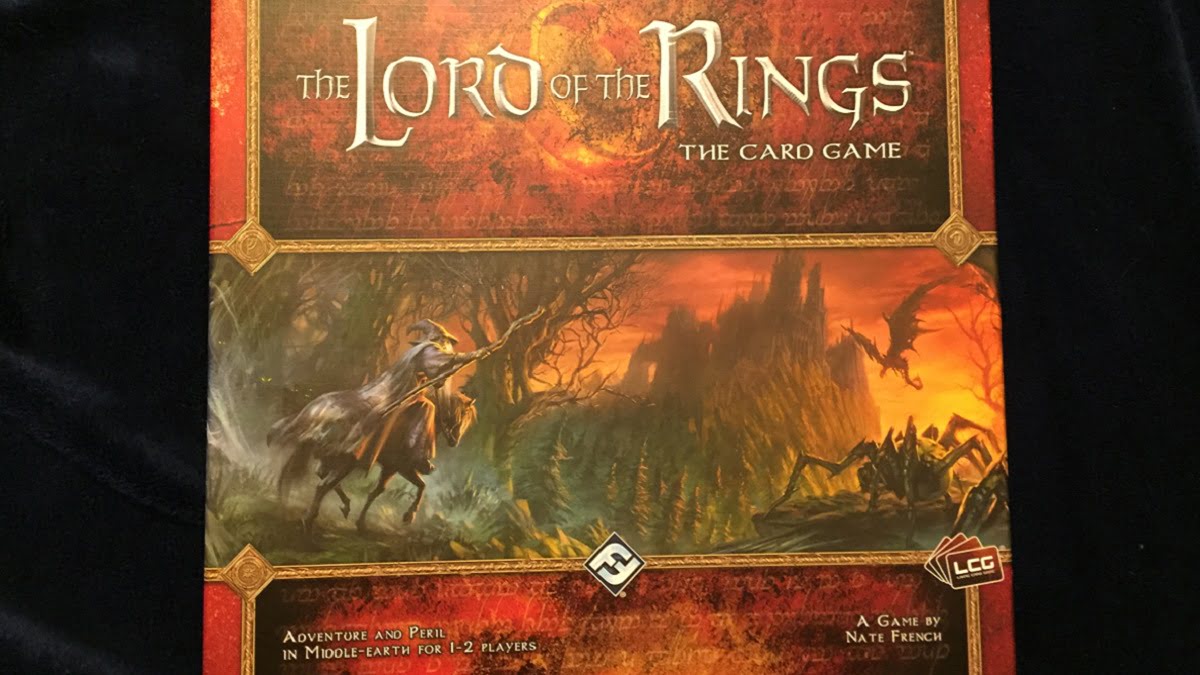Skelit’s Revenge, the most feared ship on the high seas, has finally been defeated. Now you need to loot the treasure before the ship burns down and all is lost to Davy Jones’ locker. The problem is, Captain Fromm and his skeleton crew are still wandering the ship, guarding the booty. It’s time to play Dead Men Tell No Tales.
At a glance: Dead Men Tell No Tales is a cooperative game for 2 to 5 players, ages 13 and up, and takes about 75 minutes to play. It retails for $44.99, and is available now (after funding on Kickstarter last fall). I think kids who are familiar with cooperative games like Pandemic or Flash Point: Fire Rescue would be able to pick this one up, too. There are undead skeletons roaming the ship, of course, but there’s nothing too explicit or graphic.

Components:
- 1 starting tiles
- 20 room tiles
- 7 Pirate meeples
- 30 Deckhand tokens
- 5 player boards
- 24 Fire dice (12 red, 12 yellow)
- 1 Battle die
- 20 double-sided tokens (6 Treasure/Guard, 5 Skeleton Crew/Cutlass, 3 Skeleton Crew/Grog, 6 Trapdoor)
- 26 Action tokens
- 7 Character Battle tokens
- 1 Explosion token
- 1 Captain Fromm token
- 1 cloth bag
- 19 Skelit’s Revenge cards
- 7 Character cards
- 7 Item cards
- 1 Dinghy card
- 5 player aid cards
The components are all fairly nice–sturdy cardboard and nice quality cards. The deckhands are little wooden skulls, and the pirate meeples are cute silhouettes. The artwork for the pirate cards and tokens is pretty nice, though (as usual) the female pirates are underdressed.

The player boards have a dial that shows your Fatigue level (too much and you die), and there’s also a battle track at the bottom with some circles to hold your Battle token and Sword tokens if you collect them. There’s a section cut out of the left side of the player board–it’s for you to place your character card there, but is not really necessary. You’ve also got an item card, a player aid card, and action tokens but they’re just on the table next to your board anyway.
The cloth bag is a nice soft velvet, and is used to draw the double-sided tokens from. The fire dice are small six-sided dice, brightly colored and translucent. The battle die is a regular black six-sided die, a little bit bigger than the fired dice.
The Skelit’s Revenge cards are, for the most part, pretty easy to understand: each one has a die face–red, yellow, or both–showing either a blank face or a number of pips. Below that is an icon indicating what other effect will happen. However, for some reason the “Explosion” cards (showing a 5-pip die) have a question mark icon on them, and this is different from what’s pictured in the rulebook. So the first time I played, I wasn’t sure what the rulebook was referring to.
The only complaint I have about the artwork is that there’s just a whole lot of yellow and orange. I know, the ship is on fire and there are flames everywhere, and it does look the part. However, it can sometimes be difficult to tell at a glance where there are doorways between tiles and where it’s just a wall. That, and sometimes the tokens can get lost visually because everything has a similar color. That said, the rooms do look fire-filled and hot.
How to Play
You can download a PDF of the rules here.
The goal of the game is to get treasure safely off the burning ship, and then get all the pirates out safely. The number of treasures needed to win varies with the number of players and difficulty level. At higher difficulty levels, you’ll also need to defeat all of the skeleton crew to win.
Since it’s a cooperative game, there are several ways you can lose:
- The explosion marker reaches the end of the explosion track.
- You need to add Deckhands but there aren’t any more in the supply.
- There is no place to legally place a room tile.
- Too many treasures have been destroyed.
- Somebody dies after all of the treasures have been looted.
- Somebody dies and there are no more replacement characters left.
To set up the game, you shuffle all the room tiles into a face-down stack. The starting tile is placed on one side of the table–it represents the side of the ship, so you’ll be building out in one direction. You roll two yellow dice and two red dice, and place these on the indicated spaces on the starting tile. You also place a Deckhand on the space with the trapdoor. The 20 double-sided tokens are put into the cloth bag. The explosion marker is placed near the explosion track on the starting tile. The rest of the Deckhands and dice are placed nearby in a supply.
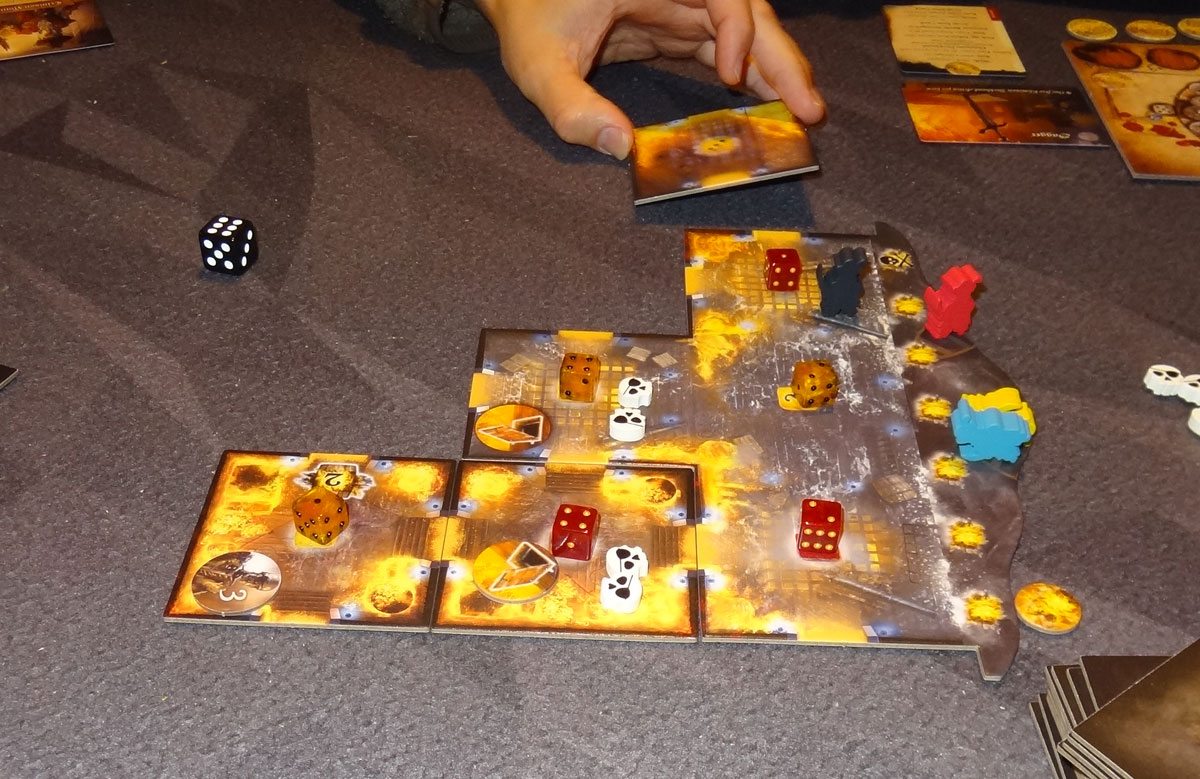
Each player gets a character card, a player board, a randomly-dealt item card, and 5 action tokens. (Lydia Lamore gets 1 extra action token.) Each character has a battle token showing the character’s face, and a meeple that matches the color. The names of the characters are also all color-based names, though we kept forgetting what color Titian and Lydia were. (Yellow and purple, in case you didn’t know.) Each player starts at 0 Fatigue. The rest of the items are laid out near the supply, and the Dinghy card is set aside for now.
Each turn, you do three things: Search the Ship, Take Pirate Actions, and Skelit’s Revenge.

Search the Ship: You turn over the top room tile and add it to the ship. (On your first turn, you’ll do this twice, to help build out the ship more quickly.) It has to be placed so that doorways match up. Then you place a fire die on it matching what’s shown. (If it has a blank die, you don’t add one.) Finally, you draw a token from the bag and add that as well–and if it’s a trapdoor, you immediately place a Deckhand next to it. Any other tokens are placed skeleton-side-up. If you place the last tile in the stack, and there’s another open door leading out from it, you place the Dinghy card next to that door–it is now an additional exit from the ship.
Skeleton Crew are carrying either swords (which help your Battle Strength) or grog (which relieves Fatigue). The higher-numbered skeletons are Guards, and they have the treasure you need to loot. Skeleton Crew can move around based on Skelit’s Revenge cards, but Guards stay put.

Take Pirate Actions: You have five Action tokens to use each turn, and any that you don’t spend can be passed along to the next player. You can use tokens for any of these actions:
- Walk (move one space)
- Run (move two spaces)
- Fight Fire (decrease the die in your room by 1 pip)
- Eliminate a Deckhand (in your room or adjacent room)
- Pick up a Token (in your room)
- Rest (lower your Fatigue by 2)
- Increase Battle Track (move your Battle token up 1)
- Swap Item Card (put your card in the supply and take any item, even from another player)
There are some other details, of course, but those are generally how you’ll spend actions. Some items have a coin (matching the Action tokens) on them–those items require an action to use. Other items give you a free action.
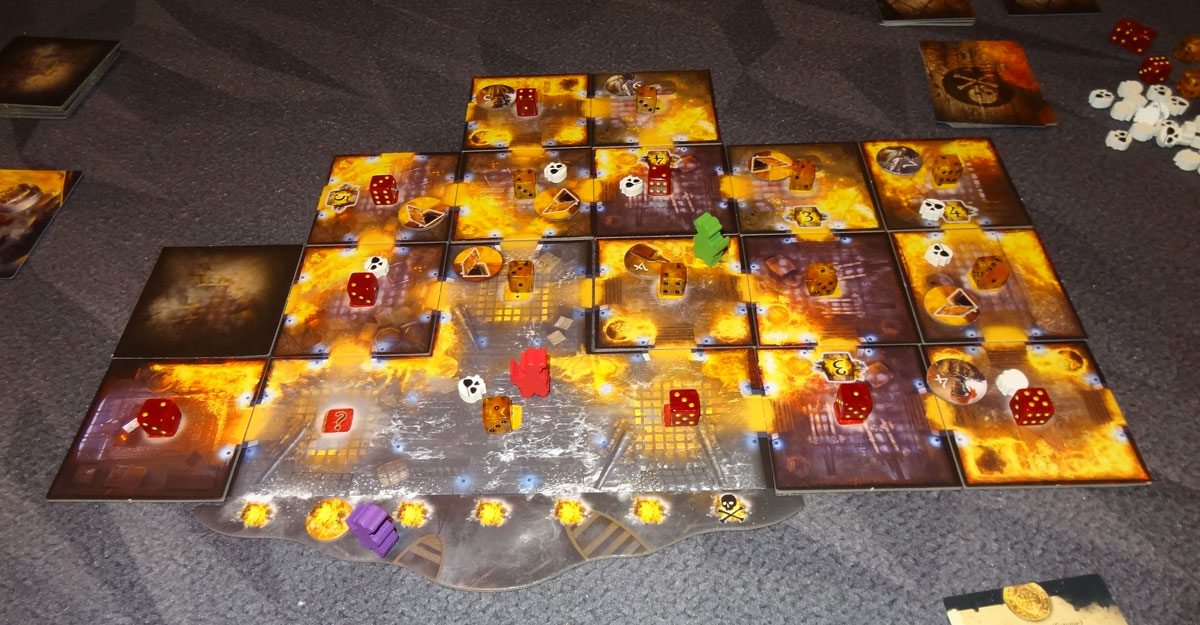
The other thing you have to deal with is Fatigue–as you move through this burning ship, it wears you down. Whenever you move into a room with a higher number on the fire die, you get Fatigue equal to the difference. And when you run, you take 2 extra fatigue. The unfortunate irony is that if you work on putting out the fire in your room, you’re going to get more fatigued when you walk out of it.
The other problem with Fatigue is that as it goes up, you are unable to enter rooms that are too hot. The Fatigue dial has some dice pictured on it–as you pass a die, you can no longer enter rooms with that number or higher. If you reach the skull, you die. If you ever exit the ship, your Fatigue goes down by half, but your turn ends immediately.
Finally, if you’re carrying treasure, you get extra fatigue, and you can’t do as much–basically walk, rest, or swap item cards. Every time you enter a room, you get Fatigue equal to the die, regardless of the number you just left.
Deckhands pop out of the trapdoors, and can spread due to Skelit’s Revenge cards. One Deckhand in a room has no effect. Two Deckhands prevent you from picking up tokens in that room. Three Deckhands prevent you from entering a room.
You flip over the Action tokens as you take actions. Once you’re done, you may pass any unused tokens to the next player.

Skelit’s Revenge: Finally, you draw the top card of the Skelit’s Revenge deck. It will show a die face and an icon below it. Any dice on the board that match the color and number shown on the card are increased by 1.
There are four icons: trap door, trap door with arrows, skeleton crew, and explosion (question mark).
- Trap door: place a Deckhand on every tile with a trap door.
- Trap door with arrows: Deckhands spread out–if a room next to a trap door has fewer Deckhands in it than the room with the trap door, add one Deckhand to it.
- Skeleton Crew: Any Skeleton Crew tokens (not Guards) on the ship will move toward the closest Pirate.
- Explosion: The 5-pip cards have an explosion, because any dice that increase to a 6 cause an explosion. When three explosion cards have been drawn, the deck is reshuffled.
Any time a die reaches 6, it explodes: first, every adjacent room that’s connected by a doorway will increase its die by 1. Then, anything inside that room is removed from the game–Deckhands, tokens, and unfortunate Pirates. Finally, the room tile is flipped over to its black side. The room is now impassable and cannot be entered for the rest of the game. Increase the Explosion Track by one.
Some of the rooms have powder kegs in them–there’s a gold barrel in one doorway with a number on it. If the die in that room reaches the number shown, the powder keg explodes and shoots through just that doorway, increasing the die in the next room. Then you move the die to the powder keg to indicate that it has already exploded, because powder kegs only explode once. However, the room itself can still explode if the die reaches 6.
Whenever you enter a room with a Skeleton Crew or Guard (or a Skeleton Crew enters your room), you must immediately fight. You roll the black Battle die, add any bonus from your items, and compare it to the Skeleton’s strength. You may also add your Battle Track modifier if you would like, but then you will need to reset your Battle Track. If your total Battle Strength is equal or greater than the Skeleton’s, then you win, and the Skeleton token is flipped over, revealing the item or loot.
If it’s less, then you gain Fatigue equal to the difference, and then you roll the Battle die again to see what the result is. Sometimes the Skeleton Crew moves, sometimes you get chased out of the room, and sometimes you have to fight again immediately. Since Guards do not move, if you lose to a Guard, you may choose to retreat or fight again.

The Battle Track lets you add bonuses to your attack, but every time you add it to your attack, you have to reset your Battle Track back to its lowest number. The sword tokens that you can pick up after defeating certain Skeleton Crew fill in the Battle Track, so that when you reset, you don’t go all the way back down to zero.

You win the game if you get enough loot off the ship and get all the pirates off safely. You lose if any of those lose conditions I listed earlier happen. However, just dying in the middle of the game doesn’t end the game–if you die, you throw away your character and draw a new one, because there are several pirates standing by. Just don’t run out of pirates before you get that treasure.
The Verdict
When I first heard about Dead Men Tell No Tales, I thought it sounded like Flash Point: Fire Rescue (a fun cooperative game) but, you know, with pirates. It’s still how I usually summarize the game, though there are actually many differences between this and Flash Point. You are fighting fires and trying to prevent too many explosions, and you are finding things and dragging them to safety (though in this case it’s loot and not victims), but you’re also exploring the ship as you play, fighting off undead pirates, and dealing with Fatigue.
The way the fires work is pretty good: although your primary goal is to get the treasure, you have to keep the ship from burning down before you get to it. So you’ll a good deal of time running to the rooms that are in danger of overheating and trying to put out fires. The problem is, with only 5 actions and the Fatigue to manage, you can’t move that quickly anyway. Fortunately, there are some items that can help: the Bucket lets you put out a fire in an adjacent room, and the Blanket lets you lower a fire die by 2 for one action. Still, there are always more fires than you’d like.
Deciding which fires to work on can also be an important decision. If you lower everything to the same number, as soon as that number is drawn, all of those rooms can increase at once. Sometimes it’s better to let one room stay hotter just so you can ensure that at least they won’t all go up at once. And, of course, managing explosions is crucial: you’ll want to watch those powder kegs and the rooms they’ll explode into, or you could find yourself with a big chain reaction.
However, because the fires increase by drawing cards from a deck, you do have at least a little bit of knowledge about the odds. If you’ve already drawn a “yellow 2” card, then you know that there’s a “red-yellow 2” left in the deck but no others, and lowering a yellow die to 2 is potentially safer than something else.
The Deckhands seem easy at first. After all, you can dispose of them for a single action, even in the room next door. But after you’ve explored the ship and there are new trap doors all over the ship, you’ll dread those “Spread Deckhands” cards, because suddenly they’re everywhere, keeping you from picking up tokens or preventing you from getting to that room that’s about to explode.
The various character abilities can be fun, though some of them seem more useful than others. But, like most cooperative games, whichever characters you don’t have are the ones you’ll feel like you could have used. Jade can dispatch two Deckhands with a single action. Crimson Flynn can lower fire levels in adjacent rooms. Five-Fingered Titian can draw 2 Skelit’s Revenge cards and decide which one to use, which gives you a peek at what to expect for the next player.
As with many cooperative games, Dead Men Tell No Tales can suffer from alpha player syndrome, where one player takes the reins and directs everyone else–that’s up to your gaming group to deal with if becomes a problem.
I’ve played several times–so far usually on the “Scurvy Dog” difficulty level (the easiest) and I’ve had more losses than victories, though I have managed to win a couple times. Some of the defeats were really close. In one instance, we found all the treasures, and were trying to get them off the ship, but we ended up with too many fires that we couldn’t keep down in time, and we had ten rooms blow up in one go, with only one treasure left to go.
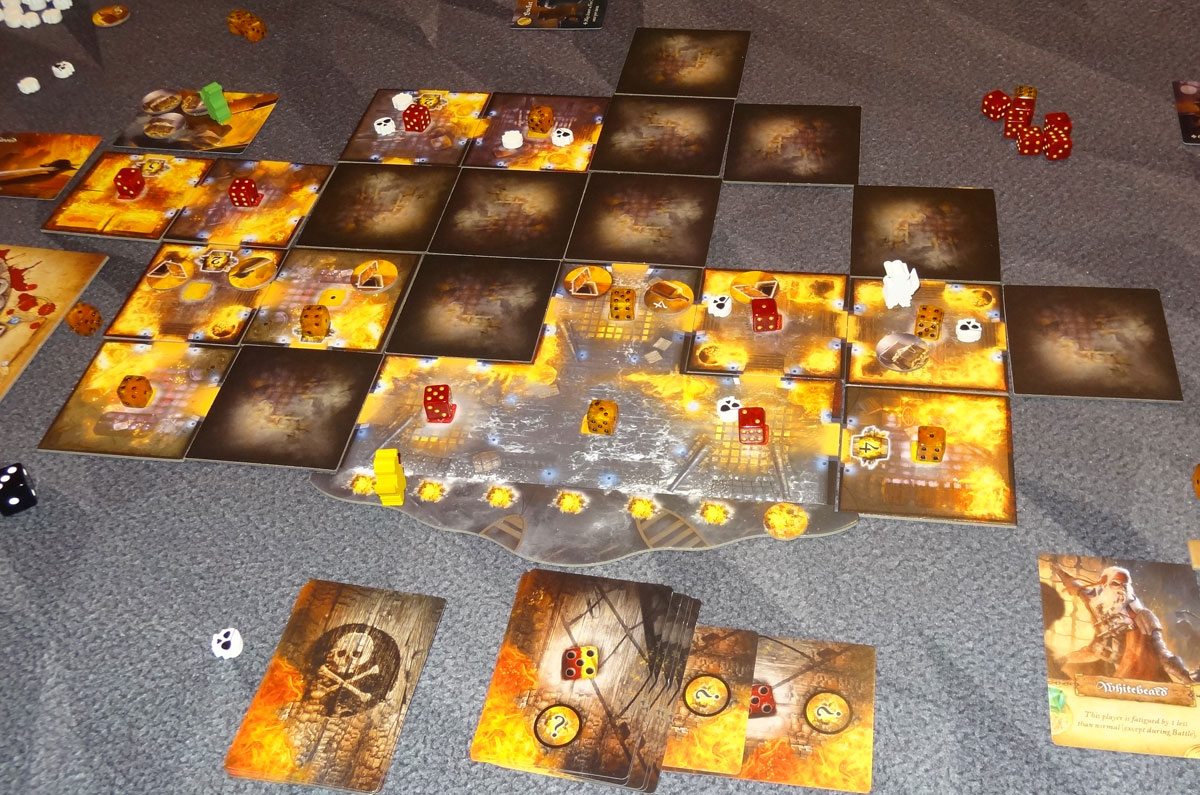
That’s one of the best parts of the game, though, that the game can come right down to the wire. I think I’m not experienced enough to start increasing the difficulty level by much, but I like that there are ways to throw in some other variations if this gets too easy.
Another aspect I like is the way you build out the ship as you play. Because each tile already has some fire level (and potentially a powder keg) on it, it matters where you put it. Do you place the tile so that it makes a nice hallway toward the other room? What if that means pointing a powder keg at a treasure? In some instances we ended up with a really long hallway because we were trying to avoid chaining powder kegs, but then there was loot at the end of the hallway that we had to drag back. In other instances, there were too many high-numbered rooms near each other that could lead to chain-reaction explosions. I like that there’s some level of strategy in the tile-laying portion of the game, even before you take your actions.
All in all, I’ve really been enjoying Dead Men Tell No Tales. It’s a fun spin on the cooperative game–yes, you’re working together, but you’re sort of greedy villains. There are a lot of meaningful choices to be made, and there’s enough danger that it builds up the tension as you play and see all those dice increasing.
I know that the first print run sold out and is all in distribution now (so you may be able to find it at your local game store or online). If you can’t find it, the second printing is expected in late August and can be pre-ordered directly from Minion Games.
Disclosure: I received a review copy of this game.
